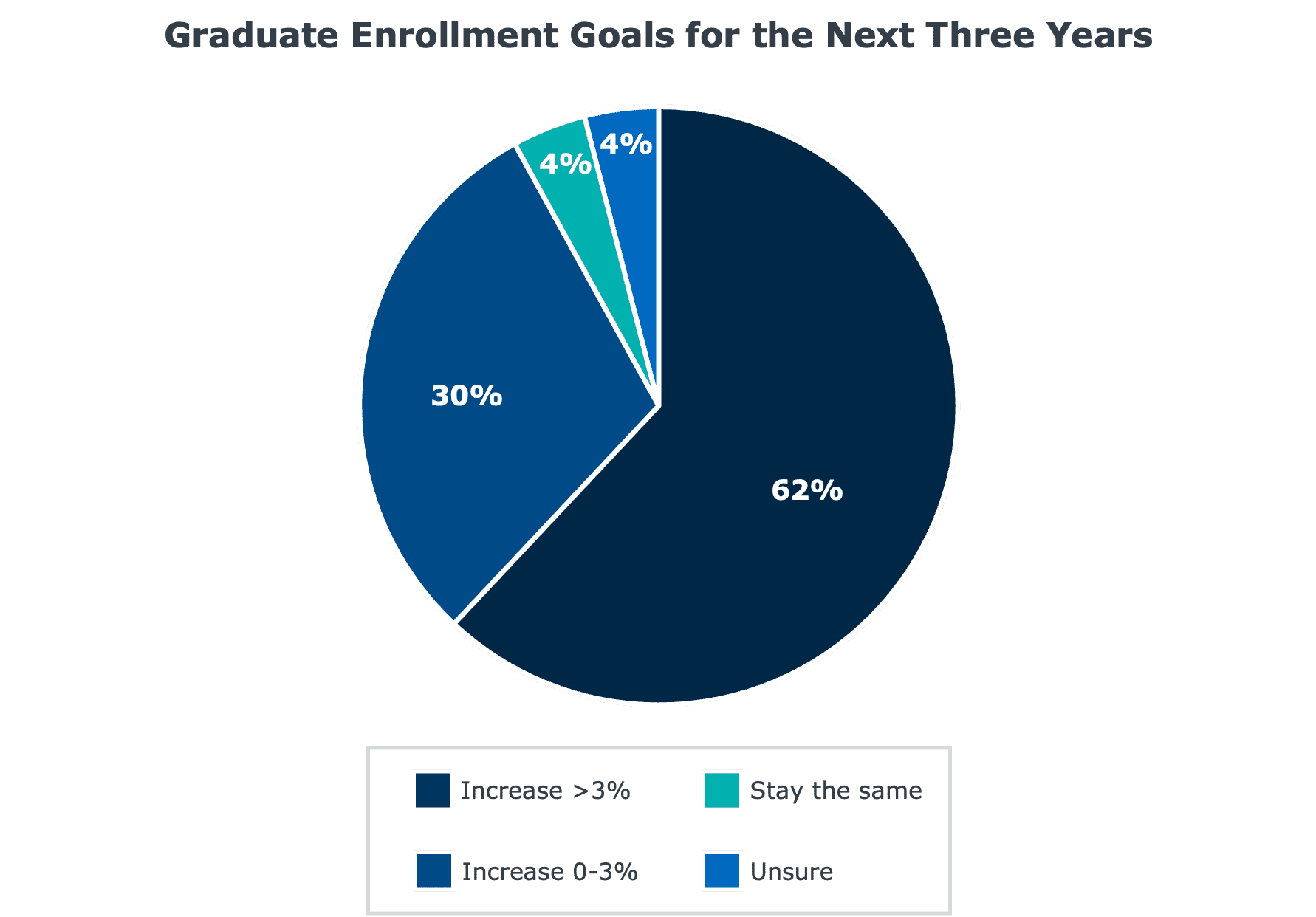The disconnect between graduate enrollment goals and resources, according to university leaders
In December, our Adult Learner Recruitment team surveyed 343 university leaders responsible for graduate enrollment, including provosts, VPEMs, and deans. The answers to the 27 questions we asked uncovered trends about organizational structure, resource allocation, enrollment priorities, and more. But one takeaway stood out to me: graduate enrollment teams are being asked to outperform the market but aren’t set up to do so.
Read on to see three insights university leaders shared about growing graduate enrollment on their campuses.
1. Growth goals are often at odds with market realities.
According to the National Student Clearinghouse, national graduate enrollment is expected to grow 1.3% annually from 2022 to 2032. While this might seem promising at first glance, it represents a significant decline from the 3.2% average annual growth we saw from 1990 to 2021. Despite this slowdown, two-thirds of the graduate enrollment leaders we surveyed said they are tasked with growing graduate enrollment by more than 3% in the coming years. An additional 30% of respondents are expected to increase graduate enrollment by 0-3%, while only 8% are charged with maintaining or decreasing total graduate enrollment.

2. Limited budgets may limit growth.
This disconnect between ambitious goals and slower growth projections is a key challenge for many teams—one that is further complicated by resource limitations. Nearly all the graduate enrollment teams I meet with identify limited resources as a major barrier to achieving their enrollment goals. Our survey showed that, on average, the total annual budget for managing graduate and online enrollment is about $912,000. This is significantly less than the average $4.37 million allocated to undergraduate enrollment management.
While our survey didn’t find any major differences in budget by institutional characteristics, it’s worth noting that simply having a larger budget didn’t correlate with meeting enrollment goals in our survey. This suggests that strategic resource allocation—not just sheer budget size—plays a critical role in overcoming these limitations.
Explore Average Budgets by Institution Size, Region, and More
3. Many schools are misallocating lead generation budget.
Speaking of strategic budget allocation: one area in which we see some schools stumble is in allocating marketing dollars, especially for lead generation. As a former university CMO, I know firsthand how difficult it can be to divvy up enrollment marketing budget across channels, each with its own variable cost and effectiveness of each. And the lead generation strategy for your MBA can and should look very different than the lead generation strategy for your nursing program, for example.
In my conversations with graduate enrollment leaders, I often find that institutions are under-investing in digital media and overinvesting in less expensive lead sources, like test-taker lists, and/or outreach to known audiences like current students and/or recent alumni that don’t require additional investments. While these sources are components of a comprehensive lead generation strategy and are less expensive, they are typically less effective in growing your prospect pool than paid search and paid social—and therefore should account for a smaller portion of your marketing spend.
Our survey findings underscore this trend. Eleven percent of respondents report an average cost-per-lead below $50; an average cost-per-lead this low suggests that enrollment teams are relying heavily on known audiences and/or less expensive test taker lists. Make sure your team is diversifying beyond those efforts with paid search and social campaigns to expand into new audiences.
Learn More About How Survey Respondents Are Allocating Marketing Dollars
How can you respond to these trends?
If these challenges—ambitious growth goals, limited resources, and misallocated marketing dollars—sound familiar, you’re not alone. Here’s my advice for overcoming these hurdles and positioning your team for success.
- Get a seat at the table during budget and goal-setting discussions: Understanding the context around resource allocation and enrollment goals is crucial. Advocate for your team by joining discussions about budget planning and goal setting, ensuring that graduate enrollment receives the funding it deserves.
- Get deep on regional trends: Understanding the nuances of your primary and secondary markets is a critical first step in advocating for resources and allocating them appropriately. Consider:
- The labor market demand trends in your state
- Trends in regional conferrals (to gauge student demand)
- Competitive concentration
- Consider reaching out to me for a custom market scan to identify opportunities and gaps in your graduate enrollment strategy.
- Highlight the net tuition revenue (NTR) that comes from your graduate programs: Revenue from graduate programs makes up a growing portion of total NTR at many institutions. Survey respondents said that, on average, 39% of their institution’s total NTR comes from graduate enrollment. Go one step further and calculate the ROI from your marketing investments based on the NTR per student and the number of new students you expect your institution to enroll. This data can help strengthen your case for additional resources.
These are just a few of the insights from our survey that will stick with me. To dive deeper into the survey findings, be sure to explore the complete results. Understanding what your peers shared about their graduate enrollment shops can help you make more informed decisions and navigate the complexities of growing grad enrollment.

More Blogs

4 questions domestic students will ask before applying to your graduate program

When Grad PLUS disappears: What 8,000+ grad students said about paying for school
